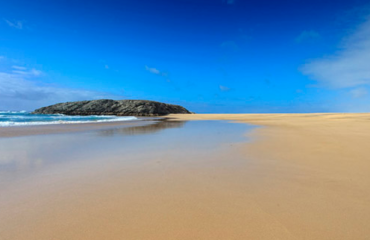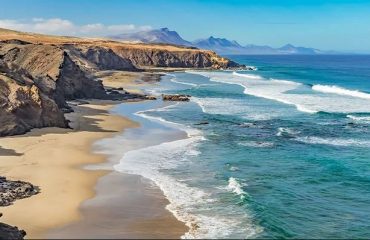This is Fuerteventura, what to visit?
Located less than 100 km from the northwest coast of Africa, there is a certain African atmosphere in its lands. People live at a very calm pace and in harmony with the beautiful nature that they are lucky enough to be able to enjoy. The beaches of Fuerteventura are its most important tourist asset, but not the only one. Often swept by a wind that delights the lovers of water sports with a board, it is the headquarters of the windsurfing world championships.

In this post we give you an idea of incredible places to visit on the island.
1. Islote de Lobos
From the port of Corralejo, every day the ferry to the islet of Lobos, a space of about 4 square kilometers whose natural beauty is protected in its entirety. They say that the islet of Lobos is a miniature representation of the best natural attractions of the Canary Islands. A volcano, a small fishing village, natural lagoons, paradisiacal beach and even a lighthouse.
When you walk through it you can not leave the path delimited by gray stones. On the way you will find the Caldera volcano – which with its 127 meters of altitude is the highest point of the island -, the turquoise waters of the El Puertito beach and the few low houses of the homonymous town.
Equap with water , sandwich and scuba glasses and enjoy this trip to one of the best places to see in Fuerteventura.
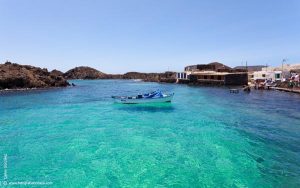
2. Peninsula of Jandía
This peninsula is separated from the rest of Fuerteventura by the Isthmus of the Wall. Undoubtedly, it is one of the places to visit in Fuerteventura, with a beautiful morphology that includes a fossil dune system.
It has two very different slopes. The one in Barlovento is less visited due to the lack of good access. Your dirt roads must be traveled on foot or in a 4 × 4 vehicle. However, the reward is good. Here is the wild beach of Cofete, with its small island and its 9 kilometers of virgin beach.
On the slopes of Sotavento is Morro Jable – one of the main tourist resorts of Fuerteventura – and 26 km of white sand beaches. The wind blows here with force, being the seat of a test of the championships of the world of windsurfing and kitesurfing.
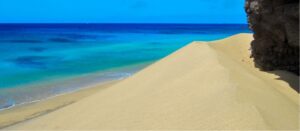
3. Mountain of Tindaya
The mountain of Tindaya – located near La Oliva, in the northwest of the island – was considered sacred by the aborigines that inhabited Fuerteventura. This is confirmed by the more than 300 engravings that have been found on its 400-meter-high stone walls.
Tindaya is arid, as arid is the landscape that surrounds it. Of course, remember that it is a protected area and of great archaeological value, for which it is forbidden to climb it. Do not risk damaging the heritage by following in the footsteps of some disrespectful tourists.
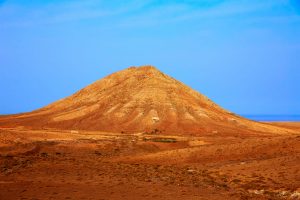
4. Natural Park of Corralejo
This Natural Park houses, along with the one of Maspalomas (Gran Canaria), the most important dune field of the Canaries.
These large dunes were formed by the disintegration and pulverization of mollusk shells and other marine organisms with a rigid external skeleton. It has an area of about 2,700 hectares and is located on the northern tip of Fuerteventura.
The spectacular landscape is completed with incredible beaches where you will find the colorful kitesurfers comets almost every day of the year.
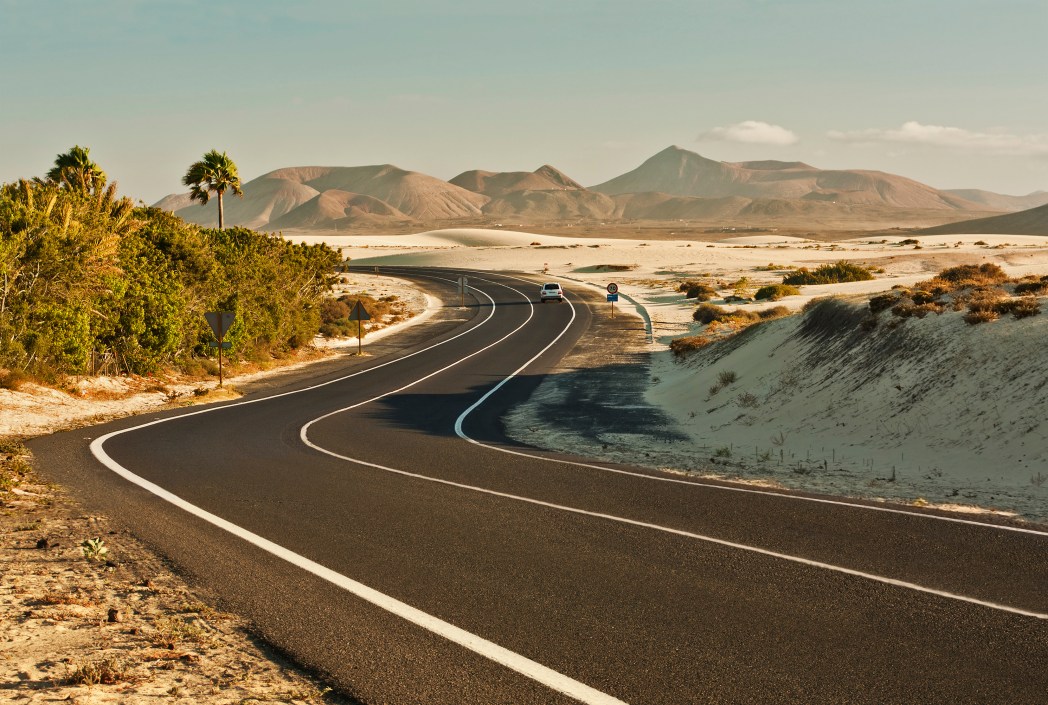
5. Mirador de Morro Velosa
Morro Velosa is the perfect place to enjoy this landscape of arid beauty and also to recreate in the viewpoint building, the work of the famous and prolific Canarian artist César Manrique. This viewpoint is an obligatory stop for those who want to discover a different Fuerteventura from the tourist postcards. The interior of this Unesco Biosphere Reserve island will surprise the visitor with its rugged landscapes without tourist centers or dunes. An almost infinite succession of rounded hills, colored in multiple ocher tones, opens before the traveler, and between them, winding ravines with few towns and hamlets on their bottoms. It is undoubtedly a surprising landscape that transmits serenity and spaciousness.

6. Pueblo de Betancuria
Betancuria, the first town in Fuerteventura to enter the Association of The Most Beautiful Towns in Spain, owes its name to the French conquistador Jean de Bethencourt. One of its architectural attractions is a visit to the first cathedral of the islands, the Church of Santa María. Betancuria offers the traveler to immerse themselves in a walk through its typical rural architecture, characterized by lime walls and wooden balconies. It has many hidden corners that surprise the tourist at every step, as well as an essence of its past as pirate communities. As if that were not enough, it is surrounded by a magnificent volcanic environment, which makes it one of the most visited places in Fuerteventura.
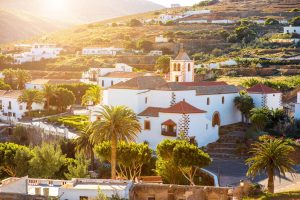
7. Barranco de los Enamorados
The Barranco de los Encantados or Barranco de los Enamorados, is located in the vicinity of the town of Lajares, municipality of La Oliva.
It is one of the most impressive landscapes of Fuerteventura, the singularity formed by the sedimentary rocks, which arise from ancient accumulations of sand located under the sea, make up an incredible place.
This spectacular paleo-dune landscape occurred more than 135,000 years ago, at the beginning of a significant drop in sea level, exposing these sediments, which are underwater sandbanks carried by the winds towards the interior of the island. No canyon in the Canary Islands presents a landscape as characteristic and peculiar as the Barranco de los Encantados: fossil dunes carved out by water. It is a unique landscape, the Barranco de los Enamorados was until recently the “Petra” of Fuerteventura and the Canary Islands.
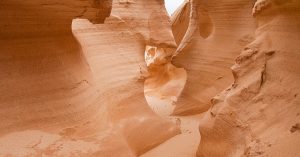
8. Aguas Verdes
Fuerteventura is synonymous with infinite beaches of fine blond sand. However, its west coast, with rougher waves, hides treasures that cannot be missed if you are looking for contrast. Aguas Verdes, in Betancuria, is one of them and perfectly sums up the wide range of virgin natural pools in the Canary Islands. About six kilometers are dotted with puddles and sea inlets worthy of a visit if the priority is relaxation and isolation without human traces. The closest human signs to this collection of pools are the asphalt road that leads to the enclave and the dirt tracks that link to the puddles. Before enjoying the sun and the water, it is not uncommon to see local squirrels, an attraction that is completed with the large crabs that inhabit the rocks. The baths in the clean and hot waters are the perfect icing on the cake to understand this visit as an alternative excursion on the island of beaches.
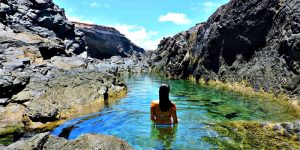
9. Jardín Botánico Fuerteventura
The area of the Botanical Garden is mainly occupied by pyroclastic products and basaltic volcanic scoria belonging to the Lower Series of the first volcanic cycle (Series I) of the Miocene. The conservation of threatened plants is one of the main missions of the botanical gardens. The Fuerteventura Botanical Garden maintains the twelve endemic species found only on the island of Fuerteventura, most of which are threatened with extinction.
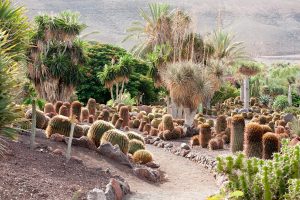
10. Cuevas de Ajuy
The oldest rocks in the Canary Islands come to the surface in the Cuevas de Ajuy, declared a Natural Monument, and located in the town of the same name, to the north of the town of Pájara. The geological wonder consists of observing with the naked eye the sedimentary substrates that were formed in the ocean depths in the Cretaceous period, between 100 and 150 million years ago. It is a fact that supposes a mystery, since the formation of Fuerteventura is dated in about 30 million years. From the access to the caves, it is worth visiting a fossilized dune, and being able to observe some old lime kilns along the way, unique for shipping the stone directly into the sea.
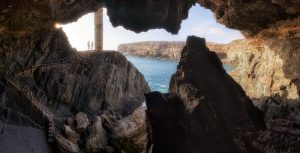
11. Morro Jable
Morro Jable was born at the beginning of the 20th century thanks to the families that settled in the area to dedicate themselves to agriculture, fishing, livestock and the lime business. Some time later, the German engineer Gustav Winter acquired the Jandía peninsula and decided to give it a strong economic boost by promoting tourism and opening the first hotel in the area.
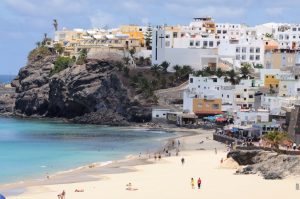
12. El Cotillo
The town of El Cotillo, in the northwest corner of Fuerteventura, has historically been a fishing village. Although in recent decades it has rebounded due to its tourist interest, it has been able to preserve its marine essence. Precisely, the practice of sports activities related to the sea is one of its main attractions, with numerous establishments and schools for surfing, kitesurfing, paddle surfing, windsurfing, or the last of these disciplines to become popular, wing foiling.
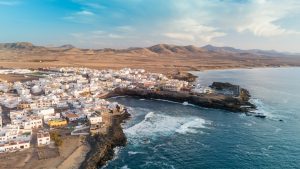
Fuente:“Skyscanner”

 Español
Español  Deutsch
Deutsch  Français
Français  Italiano
Italiano 
